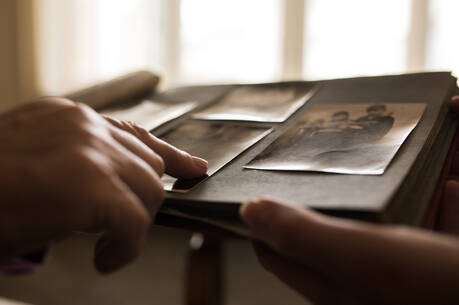Art plays a key role in America, from the cover itself to the illustrations on the inside. My awareness of this role was heightened during a recent visit to Abraham House, an organization in the Bronx that assists prisoners with their reintegration into the community. At the same time, it provides assistance to neighborhood families struggling to deal with the basic demands of food and rent. But a key part of Abraham House’s mission also concerns its after-school program for neighborhood youngsters—some of whom have relatives behind bars.
The after-school program includes instruction in art. The afternoon of my visit, one of the artists who often does work for America came to speak to the children. A young woman in her mid-20’s, Stefanie Augustine had contributed an illustration for an article on Abraham House that appeared in America last fall (9/30/02). A donor purchased the original and had it framed for presentation by Stefanie that very afternoon.
The picture shows a series of inner-city row houses like the two that Abraham House occupies. Floating high above them is a person anchored to one of the houses by a thin cord, while holding onto a feather that keeps him aloft against the sky. Stefanie explained that the person floating in the sky represents a person who has achieved freedom through the help of Abraham House, while the cord signifies Abraham House’s continuing as a source of support. Of special interest to the children was the fact that the feather was a real one, glued to the surface of the picture. And in fact virtually all the works of art Stefanie showed us from her portfolio were collages.
Questions by the youngsters were threaded throughout the talk. “Do you ever mess up?” asked one child. “All the time,” came the answer. But Stefanie went on to explain that working in a collage motif gives her the freedom simply to paint—or paste—over whatever is in need of correcting on a given picture. And besides, she added, “I don’t like to give up”— a comment that evoked approving nods from staff members who were present. “How long does it take you to do a picture?” came another question. Anywhere from one to three days, Stefanie replied. The process begins, she said, when an article needing an illustration arrives in the mail from America.
One by one she held up pictures from her portfolio, commenting on how she had created them. The children, ranging in age from elementary to high school level, were totally absorbed. “When did you begin drawing?” was another query. “When I was three or four years old,” she said, going on to add that the early instinct to draw found expression even on paper placemats in restaurants when her parents occasionally took the family out to eat. After high school, she attended the Rhode Island School of Design, from which she received a bachelor of fine arts degree after four years. But a degree does not necessarily lead to a living wage, at least not right away, and so for the first year after graduation Stefanie waited tables. Now she works at her home in New Rochelle, and her illustrations appear in other magazines besides America, including big-circulation ones like Seventeen.
After the questions and answers, Abraham House’s regular art teacher, together with Stefanie, led the youngsters off to make—what else?—collages. Equipped with scissors and glue, the younger ones began first, working animatedly together at a long table. On a strip of white paper a springtime picture gradually emerged, a suburban street lined with houses and trees, beneath a blue tissue-paper sky. The comfortable world of the collage was quite different from the world the children know in the Bronx. But the very act of making it was awakening in them an awareness of their own creative gifts. These same gifts may in turn lead to the discovery of other forms of beauty that can help them transcend, and even transform, their immediate surroundings.







